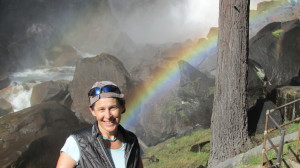Yosemite reminds us to enjoy rainbows while they last
Fresno Bee, June 13, 2014
As the Fresno Bee commemorates Yosemite history, we should consider Yosemite’s spiritual importance. The Valley is certainly awe-inspiring. It’s difficult to imagine not being moved by the view of Half Dome or the thundering spray of Yosemite Falls. In some people, Yosemite elicits an experience that may even be called “religious.”
The “Yosemite religion,” as one of my colleagues calls it, is based in the experience of the transcendent power of nature. It is connected to an ecological point of view that sees a continuum between human life and the non-human world.
If there is such a thing as the Yosemite religion, then John Muir is its prophet. For Muir, religious experience is rooted in the beauty of nature. He explained, “no synonym for God is so perfect as Beauty.” For Muir, the “sublime wonderlands” of the Sierra were manifestations of divinity.
Muir thought that city religions were weak imitations of the direct appearance of the divine in mountains, trees, and rivers. Muir explained, “the hills and groves were God’s first temples, and the more they are cut down and hewn into cathedrals and churches, the farther off and dimmer seems the Lord himself.” Muir saw himself as a modern John the Baptist. He felt called to immerse people in “the beauty of God’s mountains” and spread the good news of Sierra transcendentalism.
Evangelizing on behalf of wilderness is necessary because most people do not see the value of the wild. Some of Muir’s companions thought Yosemite was just a big hole in the ground.
As with any other kind of spiritual experience, receptivity and education matter. Some people view Christian prayer as dull recitation. Others see meditation as not much more than daydreaming. And some people, I suppose, can look at a Yosemite landscape and see only a pile of rocks.
Yosemite can also provoke uneasiness and leave people anxious to return to the city. The cliffs are daunting. The waterfalls are intimidating. And the idea of a bear in camp can make it hard to sleep.
Religions often propose a solution to our anxieties—through ritual, law, and spiritual practice, or through the intervention of a savior. Civilization offers another remedy—by softening the hard parts of life and flattening out the steeps. Civilization also keeps us so busy, that we do not think about the meaning of life—or the critters who roam the dark.
The Yosemite religion, however, offers no ritual, law, or savior. The bears still rule the night. The cliffs remain dangerous. And the trails are steep. Muir’s idea was to leave nature alone. He also encouraged us to know the earth, its ecosystems, and our place within all of that. Bears are less frightening when we understand them. And mountaineers learn quickly to respect objective danger and know their own limits.
Ecological understanding does not always satisfy our narcissistic desires. Cities and city religions celebrate the importance of humanity. But wilderness reminds us of our mortality. Earthquakes, glaciers, and rivers will eventually grind even the hardest mountain to dust. Ancient civilizations have returned to earth, while the Sequoias have endured.
The indifference of wilderness may provoke anxiety. But understanding can provide solace. From the standpoint of geological time, the beauty of these rocks, waters, and creatures is as fragile and fleeting as our very lives.
I recently took a photo of my wife standing in the middle of a rainbow beside Vernal Falls. The rainbow had appeared for a moment as the sun settled in the west. And then it was gone. We are incredibly fortunate to experience rainbows and share them with those we love. But the mountains remind us that nothing lasts forever.
Muir did not lament death and change. Rather, he celebrated the lavish abundance of nature and rejoiced and exulted “in the imperishable, unspendable wealth of the universe.”
Yosemite does elicit joy and exultation—as well as gratitude and reflection. Moments of beauty dawn for a moment and disappear. We can’t hold them. But we can love them while they last. And if we continue to preserve these wild places, we hope that tomorrow our grandchildren may find their own rainbows beneath the ever-changing falls.
http://www.fresnobee.com/2014/06/13/3976526/yosemite-reminds-enjoy-rainbows.html


